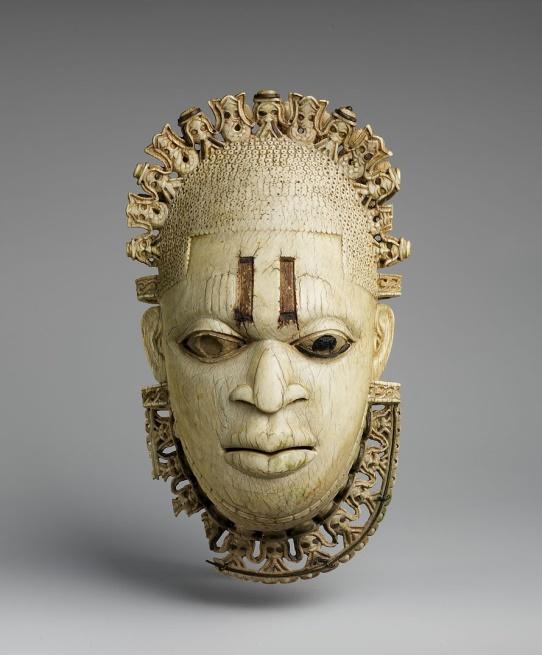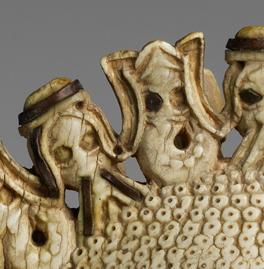
Edo is a self-taught artist from south Chicago who produces a wide range of organized eclectic artworks to narrate the history of Edo’s journey in life. The Queen Mother Pendant Mask was made in the early sixteenth century. The artistic work was done for an Oba king, Esigie, to honor his mother, Idia (Edo). The mask has a softly modeled face with naturalistic features resembling the head’s oval shape. Additionally, it features four carved scarification marks, as shown in the image below, a special number in the west African culture associated with females to represent gender.

Idia, the Queen Mother, was the first Christian kind of Benin in a region that Muslims dominated. The mask features motifs related to the Portuguese, who were the first white people to arrive in Benin in the 1490s (Edo). According to Edo, “in Benin, ivory is related to the color white, a symbol of ritual purity that is associated with Olokun, god of the sea” ( para. 2). Ivory in Benin was symbolic because it was used to attract Portuguese traders who brought wealth, such as copper, brass, and coral, to the kingdom. The crown on top of the mask features fourteen tiny figures that alternate between figures of mudfish and Portuguese heads (Edo). It was used as a symbol to equate Portuguese to mudfish, a fish that can live both in the sea and on land. This comparison showed that the Portuguese were like dead people who reincarnated. Since the Portuguese had long hair, it supported this theory because dead people’s hair was known to continue growing even after they had passed away. Additionally, these alternating mudfish and Portuguese heads symbolize the significant relations between them and the Portuguese during that period.
Queen Idia was an honored woman and a political kingpin who helped his son in times of kingdom battles aimed at expanding their territory. After winning several wars successfully, Esigie honored Idia by giving her the title of Queen Mother, a custom that has continued upto the current date. Any woman who bears Oba’s first son, the kingdom’s future ruler, is given the title Queen Mother (Edo). This woman was not allowed to give birth to other children and devoted her whole life to raising the son. Oba Esigie wore this mask mostly when attending rites commemorating his mother. It functioned as a hamlet which is evidence because of the hollow holes around the perimeter and a stopper with hair tendrils (Edo). The mask is said to have very powerful powers that could protect the wearer, and in the current day, such pendants are worn in traditional ceremonies of spiritual purification.
The iron inlays used in the rims and pupil of the eyes were used to symbolize the Queen Mother’s inner strength and authoritative gaze. In addition, two inlaid irons were on the forehead, which affirmed her authority. It has a three-dimensional form and smooth texture, which gives it a naturalistic look (Edo). The two double bars on the face of the mask represent the high medicinal power of Queen Mother. The mask has a high significance in the royal family, and anyone who wore it showed that they were a respected person in the royal family. This shows that despite the mask being an artistic feature, it carried a lot of symbolism and protected the wearer in times of war.
Work Cited
Edo. “Queen Mother Pendant Mask: Iyoba 16th Century.” Metmuseum.org, 2022.